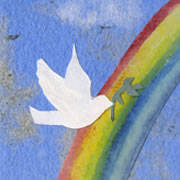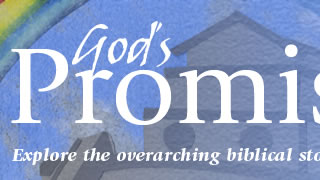 Annunciation to Mary
Annunciation to Mary
God has filled the hungry with good things
Mary’s Song promises that God will fill the hungry with good things. Engage the children in a conversation identifying what the good things might be. Encourage the children to realize that “good things” include healthy, nutritious food, a house, medicine, safety, and clean water. Children may draw pictures or write down these good things in the jar. Be sure to help the children articulate why they think each thing is good.
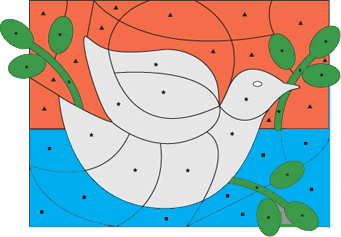 Coloring and turning right side up
Coloring and turning right side up
To do the second activity on the page, the children will need to turn the workbook upside down. Help them follow the directions so they color each space the appropriate color. Now, turn the page right side up. What picture do you see? Can you see the picture when it is upside down? What difference does it make to see things right side up?
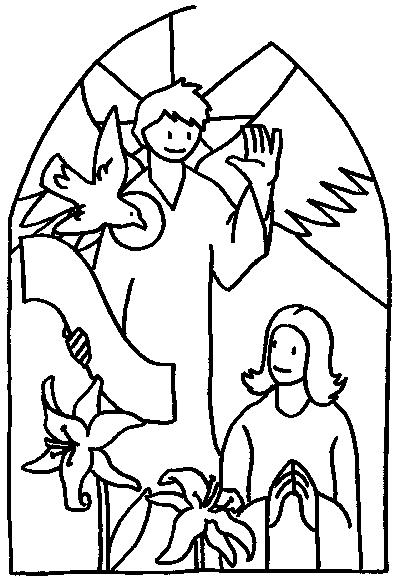 Stained Glass Window
Stained Glass Window
In this project, the children will make a “stained glass window” out of paper. The scene of the window is colored on office paper and then the picture is lightly covered with baby oil. The oil makes the picture appear to be translucent. You will need to determine if the students will create their own drawing or use the coloring page provided in the Resources section.
Directions
- Give each child a piece of office paper cut according to the pattern for the stained glass window in the Resources section. If the children will create their own images, the window shape should be blank. If the children will color in the pre-designed image, photocopy the template in the Resources section and cut along the dotted line.
- Ask the children to either draw their own picture of Gabriel talking to Mary or color the template using crayons. Explain to the children that a ½” border around the picture will not show in the finished window.
- Cover the work surface with newspaper. Place the completed window face up on the newspaper.
- Using a cotton ball lightly saturated with baby oil, gently rub the picture until it is completely covered with baby oil. You may need to add more oil to the cotton ball. As the oil absorbs into the picture, the paper will appear to be translucent.
- Position a pre-cut black construction paper window frame over the picture. Carefully turn over the frame and picture. Use masking tape to attach the frame to the picture, making sure that the tape is hidden under the black frame and does not show on the picture.
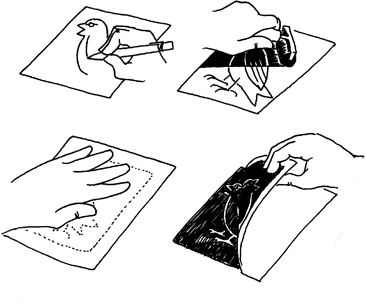 Foam Prints
Foam Prints
After reviewing Woelfel’s painting, the children will be able to figure out how to tell the story of the Annunciation to Mary using images. Guide the children in a conversation, identifying all the details that need to be included in their prints to tell the story.
Directions
- Cover the work surface with newspaper.
- Give each child a smock.
- Distribute a piece of polystyrene foam, a pencil and a pen to each child.
- Direct the children to draw their picture, including all the details they identified, with the pen and pencil on the foam. The pen and pencil will create lines of different thicknesses.
- When the drawing is complete, take a good look at the picture and be sure that the indentations made by the pen and pencil are deep enough. Deepen any lines that are not clear and strong.
- Squeeze a dab of paint onto the foam and spread evenly with the paint brayer. Use only one color paint. If the paint does not completely cover the foam, add more paint. Do not get paint into the indentations.
- Carefully invert the foam onto a piece of construction paper that is the same size.
- Press firmly and evenly. Carefully remove the piece of foam.
One Wild Game
This game is designed to provide the group with an experience of the economic discrepancies among countries around the world. Be sure to plan time to reflect on the game when the tournament is over.
Materials and Equipment
You will need the following materials for One Wild Game:
- Volleyball net or rope
- Beach ball
- Copy of the game rules
Directions
- Get the net ready and post the game rules.
- Divide the group into an even number of teams, with an equal number of students on each team. It is optimal to have two or three people on each team, and up to eight teams. If you have a large group, consider breaking the group into two groups of 16. If you have a smaller group, recruit teachers or another class to reach a goal of 16.
- Assign each team a letter. Do not tell the teams which country their team represents.
A: United States
B: Viet Nam
C: Japan
D: Ethiopia
E: Sweden
F: Laos
G: Nicaragua
H: Tanzania - Explain to the teams that their goal is to play volleyball and reach five points. When a team has scored five points, the game is ended and another game begins. The lineup will be as follows:
Game 1: A vs. B
Game 2: C vs. D
Game 3: E vs. F
Game 4: G vs. H
Game 5: Winner of Game 1 vs. Winner of Game 2
Game 6: Winner of Game 3 vs. Winner of Game 4
Game 7: Winner of Game 5 vs. Winner of Game 6
When the game is over, consider the following:
- What was it like to play the game?
- Each letter represents a real country in the world. What can you guess about the country your team was? (Provide the correct answers when done.)
- In real life some countries have more advantages than others. What are some of these advantages?
- Imagine the “Wild Game Commissioner” wanted to make the rules fair for all the teams. How would each team react? Which teams do the present rules favor? Which teams are hurt? What has to happen for all teams to agree on the rules? How does this compare to the way things really are in the world?
Game Rules
- Teams A and E ALWAYS get to choose the height of the net for each serve. They can hit the ball as many times they wish, however they wish. Basically, they can do whatever they want!
- Teams B and F may use only one hand to hit the ball. They must leave the net in the position designated by Teams A and E. C’mon you can do it!
- Teams C and G must play on their knees with the top of the net at standing up shoulder height. It’s hard, but someone’s got to do it!
- Teams D and H must lie on the ground and hit the ball only with their feet. The net should be at standing up shoulder height. Give it a good try!
